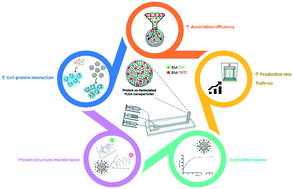当前位置:
X-MOL 学术
›
React. Chem. Eng.
›
论文详情
Our official English website, www.x-mol.net, welcomes your
feedback! (Note: you will need to create a separate account there.)
Modelling protein therapeutic co-formulation and co-delivery with PLGA nanoparticles continuously manufactured by microfluidics
Reaction Chemistry & Engineering ( IF 3.4 ) Pub Date : 2019/11/28 , DOI: 10.1039/c9re00395a Cláudia Martins 1, 2, 3, 4, 5 , Veeren M. Chauhan 6, 7, 8, 9, 10 , Amjad A. Selo 6, 7, 8, 9, 10 , Mohammad Al-Natour 6, 7, 8, 9, 10 , Jonathan W. Aylott 6, 7, 8, 9, 10 , Bruno Sarmento 1, 2, 3, 4, 5
Reaction Chemistry & Engineering ( IF 3.4 ) Pub Date : 2019/11/28 , DOI: 10.1039/c9re00395a Cláudia Martins 1, 2, 3, 4, 5 , Veeren M. Chauhan 6, 7, 8, 9, 10 , Amjad A. Selo 6, 7, 8, 9, 10 , Mohammad Al-Natour 6, 7, 8, 9, 10 , Jonathan W. Aylott 6, 7, 8, 9, 10 , Bruno Sarmento 1, 2, 3, 4, 5
Affiliation

|
Formulating protein therapeutics into nanoparticles (NPs) of poly(lactic-co-glycolic acid) (PLGA) provides key features such as protection against clearance, sustained release and less side effects by possible attachment of targeting ligands. These NPs also offer the potential for protein combination therapy, which is expected to exploit synergetic bioresponses, avoid multiple dosage regimens and consequent mis-dosing. Since the conventional manufacture of protein-loaded PLGA NPs is still associated with low-throughput, new continuous manufacturing methods such as microfluidics have been established. Herein, PLGA NPs continuously manufactured through microfluidics are proposed for co-formulation and -delivery of two model proteins consisting of bovine serum albumin (BSA) conjugated to either fluorescein (FITC) or tetramethylrhodamine (TRITC) isothiocyanates. Protein co-formulated NPs of 100 nm, monodispersed and with 70% of association efficiency were obtained. The microfluidic setup allowed a production rate of around 7 g of particles per day and demonstrated scale-up capacity. Model proteins were released in a controlled manner and without significant changes in their secondary structure. Studies in macrophage-like cells proved that protein co-formulated PLGA NPs did not impair metabolic activity (>70%). The cellular association of the proteins was around 2-times higher when co-formulated into PLGA NPs, compared to the free protein controls. Moreover, the cellular association of the co-formulated proteins was 4-times higher than the physical mixture of NPs individually loaded with each protein type. This work has demonstrated the effectiveness of continuously manufactured PLGA NPs for co-formulating and enhancing the cellular association of co-delivered model proteins, providing a proof-of-concept foundation for future protein combination nanotherapies.
中文翻译:

与通过微流控技术连续制造的PLGA纳米颗粒进行蛋白质治疗性共同配制和共同递送的建模
配制蛋白质治疗剂为聚纳米颗粒(NP)(乳酸-共-乙醇酸(PLGA)提供关键功能,例如通过可能附着靶向配体来防止清除,缓释和减少副作用。这些NP也为蛋白质联合治疗提供了潜力,有望利用协同生物反应,避免多次给药方案和随后的误用药。由于载有蛋白质的PLGA NP的常规制造仍与低通量相关,因此已经建立了新的连续制造方法,例如微流体技术。在本文中,提出了通过微流体连续制造的PLGA NP,用于共同配制和递送由两种结合到荧光素(FITC)或四甲基若丹明(TRITC)异硫氰酸酯上的牛血清白蛋白(BSA)组成的模型蛋白质。蛋白质共同配制的100 nm NP,获得单分散的并且具有70%的缔合效率。微流控设置允许每天约7 g的粒子的生产速度,并显示出规模扩大的能力。模型蛋白以受控方式释放,其二级结构没有明显变化。在巨噬细胞样细胞中的研究证明,蛋白质共配制的PLGA NP不会损害代谢活性(> 70%)。与游离蛋白质对照组相比,当共配制为PLGA NP时,蛋白质的细胞缔合大约高2倍。此外,共同配制的蛋白质的细胞缔合比每种蛋白质类型分别装载的NP的物理混合物高4倍。
更新日期:2020-02-13
中文翻译:

与通过微流控技术连续制造的PLGA纳米颗粒进行蛋白质治疗性共同配制和共同递送的建模
配制蛋白质治疗剂为聚纳米颗粒(NP)(乳酸-共-乙醇酸(PLGA)提供关键功能,例如通过可能附着靶向配体来防止清除,缓释和减少副作用。这些NP也为蛋白质联合治疗提供了潜力,有望利用协同生物反应,避免多次给药方案和随后的误用药。由于载有蛋白质的PLGA NP的常规制造仍与低通量相关,因此已经建立了新的连续制造方法,例如微流体技术。在本文中,提出了通过微流体连续制造的PLGA NP,用于共同配制和递送由两种结合到荧光素(FITC)或四甲基若丹明(TRITC)异硫氰酸酯上的牛血清白蛋白(BSA)组成的模型蛋白质。蛋白质共同配制的100 nm NP,获得单分散的并且具有70%的缔合效率。微流控设置允许每天约7 g的粒子的生产速度,并显示出规模扩大的能力。模型蛋白以受控方式释放,其二级结构没有明显变化。在巨噬细胞样细胞中的研究证明,蛋白质共配制的PLGA NP不会损害代谢活性(> 70%)。与游离蛋白质对照组相比,当共配制为PLGA NP时,蛋白质的细胞缔合大约高2倍。此外,共同配制的蛋白质的细胞缔合比每种蛋白质类型分别装载的NP的物理混合物高4倍。











































 京公网安备 11010802027423号
京公网安备 11010802027423号